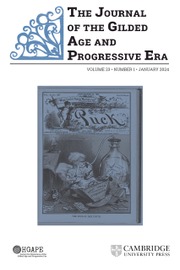John Weber’s research for William Hanson and the Texas-Mexico Border: Violence, Corruption, and the Making of the Gatekeeper State began, Weber admits, as something of a “perverse fascination” with its subject (5). It is not a biography, Weber insists, at least not of the man himself. Very little is known about Hanson’s personal life, and so Weber instead focuses on the political imprint Hanson left from his various roles as a lawman, lackey, and bureaucrat. I would argue, though, that this book is, in fact, a kind of biography: not of one man, but of the monster he served – a growing Progressive Era state apparatus obsessed with maintaining racial hierarchies, manifesting imperial ambitions, and crafting a harsh regime of immigration and border control.
It is these three historiographies that Weber’s book engages – and engages expertly. Through a careful exploration of one bureaucrat’s professional trajectory, Weber contributes to our growing but still incomplete understanding of the Texas Rangers and its breathtakingly violent history, adds to our knowledge of the terrifyingly rapid and efficient growth of the imperial state during the Progressive Era, and builds on important research on the emergence of the “gatekeeper state” so recognizable to us today. Weber manages to draw from all of these different threads, honoring the profoundly important work of historians in these fields who have laid critical groundwork over the past few decades, while also writing an original and fascinating story of a man who embodied the worst impulses and excesses of the period.
Written in two parts, each spanning two chapters, Weber’s brisk narrative first covers Hanson’s time as a counter-revolutionary agent with eyes on, and for a time a presence in, Mexico. He shows how our villain (I think it is fair to frame him this way; elsewhere, in the “Refusing to Forget” project, Weber rightly accuses Hanson of “mass murder”) used his position as a Texas Ranger captain to try to destabilize the emerging postrevolutionary order in Mexico.Footnote 1 At the same time, Hanson was using brute force to shape electoral politics in Texas, regularly engaging in grotesque acts of violence against Mexican and Black people in the state – and then to hide evidence of those atrocities, as the case of the 1918 Porvenir Massacre illustrates. The second chapter probes Hanson’s work under Albert Bacon Fall, for whom he served as a kind of human Swiss Army knife. As an aide to the Senator-turned-Interior Secretary, famous for his involvement in the 1920s Teapot Dome Scandal, Hanson used his “position in the shadows” to continue meddling in Mexican affairs, particularly to protect the interests of U.S. oil there, for which he was handsomely rewarded (8). The second part – the final two chapters – examines Hanson’s time with the Immigration Service, which was just being established when he joined.
Of the four chapters, I found the second (Hanson’s time with Fall) somewhat less interesting than the others and a bit thinner on substance. This characteristic is likely due to a limited source base, though its inclusion was necessary given its transitory role in Hanson’s life. The first chapter, however, is enlightening, as it shows just how dramatic the growth of state power was during this period, and how consequential it became, not only for Texas, but for the entire country and, indeed, the hemisphere. The last two chapters, meanwhile, are the most fascinating and arguably the most important. Although the arguments on which the narrative rests are not necessarily new or novel, Weber’s insights and examples certainly are. For instance, it is well known by now that immigration control is largely “performative,” and that deportation has always been less about maintaining law and order and territorial integrity than it has been a blunt instrument of social and labor control (134). Yet Weber shows and does not just tell. Most notably, the author details how Hanson employed a bizarre but effective smuggling scheme wherein he allowed smugglers to bring in Mexican workers and liquor while forcing them to turn over European migrants, who had just been barred by the 1924 Immigration and Nationality Act. In so doing, Hanson gifted the United States what it craved most – cheap labor and booze – while proclaiming success in keeping out unwanted immigrants. The entire ploy serves as a microcosm, really, of all of U.S. immigration history, and it illustrates the broad power that bureaucrats have always had in shaping immigration policy on the ground.
Weber compellingly argues that Hanson matters not because of who he was but because of what he represented. He is largely unknown, after all, because he was neither a politician nor a policymaker. He was merely an enforcer, an opportunist, and the beneficiary of a vision already tailor-made for people like him. But by focusing on this one man’s legacy of corruption, brutality, and greed, Hanson shows the terrifying reach of plenary power, the vast and injurious potential of unchecked authority, and the terrifying purchase of anti-immigrant sentiment, which as Weber shows, can be a matter of life and death for the most vulnerable. Indeed, Weber spills considerable ink recounting the revealing and instructive example of Abelardo Hinojosa and Demetrio Torres, two Mexican political refugees who, as a result of Hanson’s efforts, were apprehended and deported to Mexico, where the government executed them.
In the end, Weber tells us, Hanson died a pathetic man “just barely getting by” with no money, power, or influence (155). But as we learn from this book – which is accessible, well-written, well-organized, and effectively framed – Hanson’s ghost very much still haunts the borderlands and immigration policy, even today. This book, therefore, is as relevant for scholars of the Progressive Era as it is for those of us who study the more recent past, especially historians of race, ethnicity, and immigration. It is a terrific book and a welcome contribution to a subject painfully relevant in 2024.


